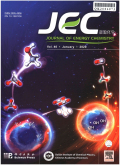- 钛学术文献服务平台 \
- 学术期刊 \
- 工业技术期刊 \
- 石油与天然气工业期刊 \
- 能源化学期刊 \
Investigating the effect of cosolvents on P3HT/O-IDTBR film-forming kinetics and film morphology
Investigating the effect of cosolvents on P3HT/O-IDTBR film-forming kinetics and film morphology
基本信息来源于合作网站,原文需代理用户跳转至来源网站获取
摘要:
The morphology of active layer in bulk heterojunction(BHJ)organic solar cells is decisive to the device performance.Previous works have shown that the solvent engineering is an effective method to optimize the morphology of active layer.However,screening the proper solvent is a tedious task,and we know very little about how to select a proper solvent for a particular system,especially for polymer/non-fullerene blend systems.Here,we combined the spectroscopic analysis in various solvent mixtures dur-ing film-forming process to reveal the relationship among the cosolvent characteristics,film-forming kinetics and film morphology.In this article,P3HT/O-IDTBR blend was selected as model system due to being facile synthesized under a large-scale.Chlorobenzene(CB)was selected as main solvent,and the cosolvents were grouped into three categories according to its boiling point(bp)compared to CB.The cosolvents with lower bp,like chloroform(CF),can facilitate a faster film-forming process,reducing the domain size but sacrificing the crystallinity of both components.For the cosolvents with higher bp,like o-dichlorobenzene(DCB)and 1,2,4-trichlorobenzene(TCB),the self-organization process of P3HT and O-IDTBR is separated and its duration was extended,constructing highly crystalline nano-interpenetrating network.However,the cosolvents with very high bp,such as chlomaphthalene(CN),would residue in film and keep P3HT and O-IDTBR self-organizing for longer time,leading to larger phase separation.This work systematically investigated the effect of cosolvent on the film-forming kinetics,and proposed a guideline of how to select a proper cosolvent according to the crystallinity and domain size of active layer.

推荐文章
P3HT∶Ag@C复合膜的制备及其光学性能
核壳结构
碳包银复合材料
复合膜
光学性能
磁场对P3HT∶PCBM活性层的薄膜形貌及光电性能的影响
聚合物太阳能电池
磁场
形貌
P3HT∶PCBM
相分离
基于TiO2/Perovskite/P3HT结构的n-i-p型钙钛矿电池的电极界面优化与器件性能
钙钛矿太阳能电池
n-i-p结构器件
TiO2电子传输层
P3HT空穴传输层
内容分析
关键词云
关键词热度
相关文献总数
(/次)
(/年)
引文网络
引文网络
二级参考文献 (0)
共引文献 (0)
参考文献 (1)
节点文献
引证文献 (0)
同被引文献 (0)
二级引证文献 (0)
2020(1)
- 参考文献(1)
- 二级参考文献(0)
2020(1)
- 参考文献(1)
- 二级参考文献(0)
- 引证文献(0)
- 二级引证文献(0)
引文网络交叉学科
相关学者/机构
期刊影响力
能源化学
主办单位:
中国科学院大连化学物理研究所
中国科学院成都有机化学研究所
出版周期:
双月刊
ISSN:
2095-4956
CN:
10-1287/O6
开本:
出版地:
大连市中山路457号
邮发代号:
创刊时间:
语种:
eng
出版文献量(篇)
2804
总下载数(次)
0
总被引数(次)
7996
期刊文献
相关文献
推荐文献
- 期刊分类
- 期刊(年)
- 期刊(期)
- 期刊推荐
一般工业技术
交通运输
军事科技
冶金工业
动力工程
化学工业
原子能技术
大学学报
建筑科学
无线电电子学与电信技术
机械与仪表工业
水利工程
环境科学与安全科学
电工技术
石油与天然气工业
矿业工程
自动化技术与计算机技术
航空航天
轻工业与手工业
金属学与金属工艺
能源化学2022
能源化学2021
能源化学2020
能源化学2019
能源化学2018
能源化学2017
能源化学2016
能源化学2015
能源化学2014
能源化学2013
能源化学2012
能源化学2011
能源化学2010
能源化学2009
能源化学2008
能源化学2007
能源化学2006
能源化学2005
能源化学2004
能源化学2003
能源化学2002
能源化学2001
能源化学2020年第9期
能源化学2020年第8期
能源化学2020年第7期
能源化学2020年第6期
能源化学2020年第5期
能源化学2020年第4期
能源化学2020年第3期
能源化学2020年第12期
能源化学2020年第11期
能源化学2020年第10期
能源化学2020年第1期

 免费查重
免费查重










